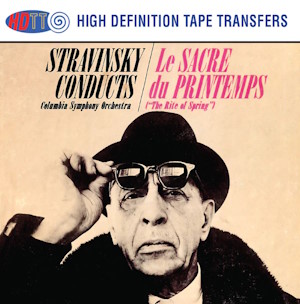
Igor Stravinsky (1882-1971)
Le Sacre du Printemps (The Rite of Spring) (revised 1947 version)
Columbia Symphony Orchestra/Igor Stravinsky
rec. January 1960, New York City
(Redux) – 24/352.8 DXD PCM Flac Digital Download
High Definition Tape Transfers HDTT15332 [32]
First, the technical stuff, quoted from the HDTT website: “Sourced from a 15ips 2-track tape…This release was edited in DXD PCM from a DSD256 Master then the DXD edited master was used to generate the final DSD files using Merging Technologies Album Publishing. DXD (352.8KHz 24/32 bit PCM) is one of the best and least destructive formats for post-processing DSD originated digital recordings.”
This must be good news, as virtually everything I have heard from HDTT is sonically a marked improvement over previous issues. In my review of Teodor Currentzis’ controversial recording I remarked, “Stravinsky’s own recording, while swift and incisive, is in muddy sound and tends to confirm the observation that composers do not necessarily make the best conductors of their own music. He fails to generate the excitement and tension of the best versions” and in his review over two decades ago of this performance released on Sony, my colleague Jonathan Woolf observed “the sound remains, as ever, somewhat less than ingratiating and nothing will change the relative dynamic constriction. But equally every page teems with detail and colour.”
Reviews posted on their website are uniformly enthusiastic, proclaiming that this new Redux edition to be “outstanding…not just an improvement, [but] an astonishing step to a new level. The musical transients are now crystal clear, making the often complex textures open up from top to bottom. The instruments, most noticeable in the winds, sound utterly natural. The music seems to emerge from a black background and the treble end of the spectrum is completely free of glare”…” I would never have expected the Columbia engineers had this much dynamic contrast, detail and transparency hidden in their tapes”…”So much more involving and intimate, with so much more decay and hall ambience. Bass drum more firmly placed behind orchestra and ‘tribal’ percussion so much more clear. Oddly though, it sounds like a different mix altogether in some places, especially from the Sacrificial Dance onward.”
I quote these reviews as they are so positive and comprehensive in their praise. Furthermore, the “Sacrificial Dance” from this recording was selected by NASA to be included on the gold-plated copper record sent into space on the Voyager space craft in 1977.
However, in the face of such overwhelmingly convincing encomia let me for a moment play devil’s advocate and restore some balance by pointing out that all you get here is 35 minutes of music – no fillers, bonuses or the customary companion ballets such as The Firebird or Petrushka – and the general critical verdict has been that Stravinsky was never the best conductor of his own works . Having said that – and once again I am lazy enough to quote the website rather than paraphrase – “Stravinsky collaborated with the Columbia Symphony Orchestra to record many of his works. These recordings offer valuable insights into his interpretation of his own compositions. They showcase his authoritative understanding of the music and his ability to convey the intended expressive elements.
Stravinsky’s recordings of “The Rite of Spring” are considered significant historical documents. They allow listeners to hear the composer’s own perspective on one of the most groundbreaking works in classical music. This Redux release features significantly improved sound quality compared to the previous version.”
All of which serves as an introduction to my own response to listening to the download of this new release. A little background rumble notwithstanding, this is extraordinarily present and immediate, every instrumental strand wonderfully transparent. Is it as red, raw and raucous as favourite recordings by Ozawa, Gergiev, Currentzis and a young Rattle with the National Youth Orchestra? Not quite – but it is still damn good; the pizzicato plunks, the whooping horns, the thunderous timpani, the groaning double basses, the splashy tam-tam – they’re all so vivid, while in the background, towards the end of the Spring Round Dances, you can faintly hear the composer-conductor’s exhortative grunts. Despite his age and infirmity, he certainly gauges and generates the required increase of tension during the wildest movements such as the Games of the Rival Tribes and the Dance of the Earth with great energy – and technically, insofar as my amateur ears can judge, the “Columbia Symphony Orchestra” – mostly, of course, the New York Philharmonic, already galvanised by a Dream Team of a successive trio of music directors in Stokowski, Mitropoulos and Bernstein – are fully up to the music’s demands. I could, however, do with hearing more brooding mystery in the Introduction to the second half, The Sacrifice; it is a touch rushed and perfunctory. However, the Glorification is thrilling, the brass playing in the Summoning of the Elders has penetrative brilliance and the marvellously syncopated finale really delivers.
No doubt about it: if you want to hear Stravinsky conduct his own most famous work in what is by far the best sound to date, this is it.
Ralph Moore
Availability: High Definition Tape Transfers


















